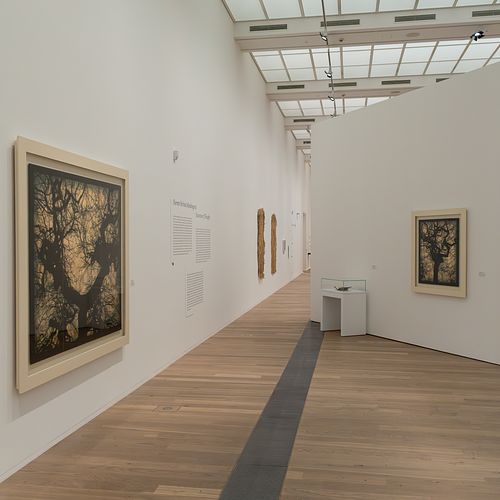AUDIO
Nomen Herbae Mandragora | Structure of Thought
The exhibition begins with two works by the brothers Doug and Mike Starn from their series Structure of Thought. At first glance, their pictures look like a tangle of dark areas and lines against a light background, but in fact they turn out to be photographs of bare treetops. Looking more closely, we can see that the large-scale pieces consist of a mosaic of equal-sized rectangles, which conceal other depictions of intertwined branches. The Starn brothers achieve this effect by printing their photographs on transparent paper in two layers.
A fifteenth-century illustration of the mandragora or mandrake accompanies the photographs. The illustration comes from the Herbarium Apulei Platonici, the first printed book devoted exclusively to plants. In the past, people believed the mandrake to have healing powers – it was said to bring prosperity and happiness in love. Legend has it that the mandrake emits a deadly howl when uprooted, so it had to be pulled out of the ground by a dog. What makes the mandrake root special are its humanlike features: the illustration depicts the root as a human body with leaves for a head and roots for fingers and toes. This exaggerated depiction reveals the deep roots of the idea of a close relationship between plants and human beings.
The Starn brothers’ photographs and the depiction of the mandragora echo Plato’s parable. By fusing human and plant features, the image of the mandrake expresses human beings’ ability to put down roots. We can interpret Doug and Mike Starn’s trees, in turn, as metaphors for thought processes. On the one hand, the branching structures remind us of the brain and its neural pathways; on the other hand, they reflect the associative and fragmentary way the brain processes information. This creates a visual image of the way people think, and of how we are rooted in our environment.
A fifteenth-century illustration of the mandragora or mandrake accompanies the photographs. The illustration comes from the Herbarium Apulei Platonici, the first printed book devoted exclusively to plants. In the past, people believed the mandrake to have healing powers – it was said to bring prosperity and happiness in love. Legend has it that the mandrake emits a deadly howl when uprooted, so it had to be pulled out of the ground by a dog. What makes the mandrake root special are its humanlike features: the illustration depicts the root as a human body with leaves for a head and roots for fingers and toes. This exaggerated depiction reveals the deep roots of the idea of a close relationship between plants and human beings.
The Starn brothers’ photographs and the depiction of the mandragora echo Plato’s parable. By fusing human and plant features, the image of the mandrake expresses human beings’ ability to put down roots. We can interpret Doug and Mike Starn’s trees, in turn, as metaphors for thought processes. On the one hand, the branching structures remind us of the brain and its neural pathways; on the other hand, they reflect the associative and fragmentary way the brain processes information. This creates a visual image of the way people think, and of how we are rooted in our environment.
